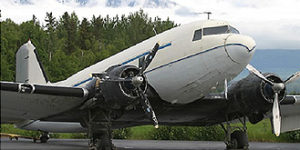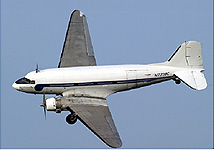Douglas DC-3 Series Available For Cargo Charter
Type: Turboprop Airliners
National Origin: United States
Manufacturer: Douglas Aircraft Company
First Flight: December 17, 1935
Status: In Service
Number Built: 16000+
Variants: DC-3
The Douglas DC-3 is an American fixed-wing, propeller-driven aircraft whose speed and range revolutionized air transport in the 1930s and 1940s. Because of its lasting impact on the airline industry and World War II, it is generally regarded as one of the most significant transport aircraft ever made.
Early U.S. airlines like United, American, TWA and Eastern ordered over 400 DC-3s. These fleets paved the way for the modern American air travel industry, quickly replacing trains as the favored means of long-distance travel across the United States. Piedmont Airlines operated DC-3s from 1948 to 1963. A DC-3 painted in the representative markings of Piedmont, operated by the Carolinas Aviation Museum, continues to fly to air shows today and has been used in various movies. Both Delta and Continental Airlines operate “commemorative” DC-3s.
During World War II, many civilian DC-3s were drafted for the war effort and just over 10,000 US military versions of the DC-3 were built, under the designations C-47, C-53, R4D and Dakota. Peak production of the type was reached in 1944 with 4853 being delivered. The armed forces of many countries used the DC-3 and its military variants for the transport of troops, cargo and wounded. Licensed copies were built in Japan as Showa L2D (487 aircraft) and in the USSR as the Lisunov Li-2.
After the war, thousands of surplus C-47s were converted to civil service and became the standard equipment of almost all the world’s airlines, remaining in front line service for many years. The ready availability of ex-military examples of this cheap, easily-maintained aircraft (it was both large and fast by the standards of the day) jump-started the worldwide, post-war air transport industry.
Douglas had developed an improved version, with a greater cargo capacity and a different wing, which it attempted to sell during this time frame but with all these surplus aircraft, the Super DC-3 did not sell in the civil market. The U.S. Navy had 100 of their early R4Ds converted to Super DC-3 standard as the R4D-8, later C-117D.
Numerous attempts were made to design a “DC-3 replacement”, over the next three decades (including the very successful Fokker F27 Friendship) but no single type could match the versatility, rugged reliability and economy of the DC-3 and it remained a significant part of air transport systems, well into the 1970s. Even today, over 70 years after the DC-3 first flew, there are still small operators with DC-3s in revenue service and as cargo planes. The common saying among aviation buffs and pilots is that “the only replacement for a DC-3 is another DC-3.” The aircraft’s legendary ruggedness is enshrined in the lighthearted description of the DC-3 as “a collection of parts flying in loose formation”. Its ability to take off and land on grass or dirt runways also makes it popular in developing countries, where the runways may not always be a paved surface.





